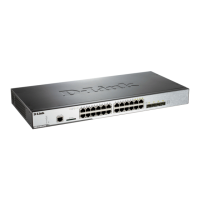DWS-3160 Series Gigabit Ethernet Unified Switch Web UI Reference Guide
361
Display the 802.11 mode being used on the AP.
Security mode used by the AP.
Display whether this AP supports IEEE 802.11n mode.
Beacon interval for the neighbor AP network.
Highest Supported Rate
Highest supported rate advertised by this AP in the beacon frames. The rate is
represented in increments of 1 Mbps.
Display whether this AP is managed by a switch in the cluster.
Display whether the beacon frame was received from an ad hoc network.
OUI Description
Display the manufacturer of the AP or wireless client adapter based on the
information in the OUI database on the switch.
After clicking the AP Triangulation Status tab, the following page will appear:
Figure 2-31 AP RF Scan Status – AP Triangulation Status window
The fields that can be displayed are described below:
Parameter Description
Detected AP MAC
The Ethernet MAC address of the detected AP. This could be a physical radio
interface or VAP MAC. For D-Link APs this is always a VAP MAC address.
Display whether the AP that detected the entry is in sentry or non-sentry mode.
MAC Address
Display the MAC address of the AP that detected the RF Scan entry. The address
links to the Valid AP database.
Display the radio on the AP that detected the RF Scan entry.
RSSI(%)
Display the received signal strength indicator in terms of percentage for the non-
sentry AP. The range is from 0 to 100%. A value of 0 indicates the AP is not
Signal Strength(dBm)
Received signal strength for the non-sentry AP. The range is from -127 dBm to 127
dBm, but most values are expected to range from -95 dBm to -10 dBm.
Noise reported on the channel by the non-sentry AP.
Time since this AP was last detected in an RF scan.

